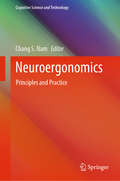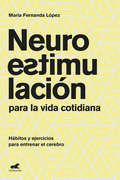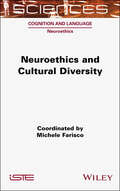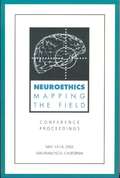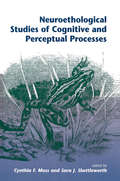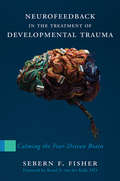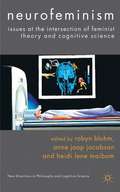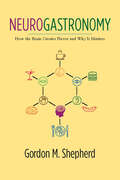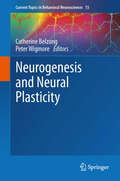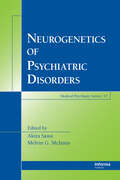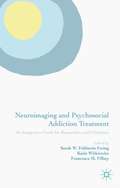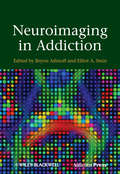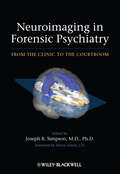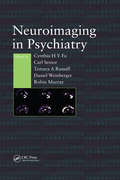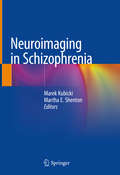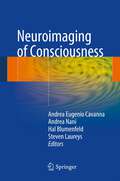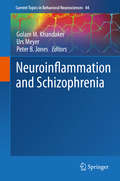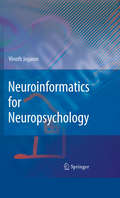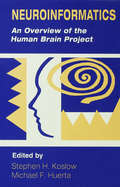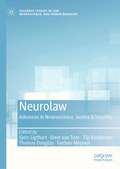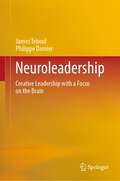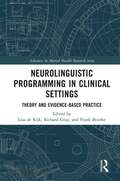- Table View
- List View
Neuroergonomics: Principles and Practice (Cognitive Science and Technology)
by Chang S. NamThis book sums up key research findings, and theoretical and technological advances having a direct bearing on neuroergonomics. Neuroergonomics is an emerging area whose Neuroergonomics is an emerging area that is collectively defined as the study of human brain function and behaviour in relation to behavioural performance in natural environments and everyday settings. It helps readers to understand neural mechanisms of human cognition in the context of human interaction with complex systems, as well as understanding the change of perception, decision-making and training in humans. The authors give new insights into augmenting human performance, reflecting upon the opportunities provided through neuroergonomics research and development. Computer systems acting on data from behavioural-output, physiological, and neurological sensing technologies are used to determine the user’s cognitive state and adapt the systems to change, support, and monitor human cognition. Various domains and case studies delve into the field of neuroergonomics in detail. These include, but are not limited to:an evaluation of technologies in health, workplace, and education settings, to show the different impacts of neuroergonomics in everyday lives;assessment of real-time cognitive measures;dynamic casual interactions between inhibition and updating functions, through analysis of behavioral, neurophysiological and effective connectivity metrics; and applications in human performance modelling and assessment of mental workload, showing the reader how to train and improve working memory capacity.Neuroergonomics: Principles and Practice provides academic practitioners and graduate students with a single go-to handbook that will be of significant assistance in research associated with human factors and ergonomics, human-computer interaction, human-systems engineering and cognitive neuroscience.
Neuroestimulación para la vida cotidiana: Hábitos y ejercicios para entrenar el cerebro
by María Fernanda LópezA lo largo de este libro vamos a ir descubriendo de qué manera podemos beneficiarnos en nuestras actividades diarias, cómo darle una vuelta de tuerca a nuestro modo de vida para que lo cotidiano deje de ser rutinario y comience a neuroestimular el cerebro. "¿Qué venía a buscar?" "¿Qué te iba a decir?" Estas son las clásicas preguntas que nos hacemos todos los que tenemos más de treinta años, y cuando hablamos de esto con amigos todos decimos: "A mí me pasa lo mismo" o "Es la edad. De más está decir que la única respuesta que tiene sentido, y es real, es la primera, pues a todos nos puede pasar que nos olvidemos de algo. Porque estamos apurados, ansiosos o estresados; porque andamos haciendo muchas cosas a la vez o porque no descansamos adecuadamente. Envejecer no es sinónimo de deterioro, sino parte del crecimiento, de la evolución, y la edad no tiene por qué limitarnos en nuestra vida cotidiana. La vida moderna hace que corramos de un lugar a otro. El reloj se convierte en nuestro peor enemigo cuando nos damos cuenta de que no nos alcanzan las horas para todo lo que tenemos que hacer y no encontramos tiempo para nosotros, mucho menos para cuidar y neuroestimular el cerebro. Buscamos opciones: talleres de memoria, revistas de sudokus, sopas de letras, crucigramas y demás juegos de mente. ¿Es verdad que ir a talleres de memoria o realizar ese tipo de ejercicios es bueno para mantener el cerebro activo? Sí, son una opción y muy valiosa, pero no la única. Buenas noticias: podemos neuroestimular el cerebro, rejuvenecerlo o, mejor dicho, mantenerlo joven y ágil estando activos. A lo largo de este libro vamos a descubrir de qué hablamos cuando hablamos de neuroestimular el cerebro, cuáles son las funciones cognitivas y cómo se va transformando este órgano con el pasar de los años. Después veremos cómo aprovecharnos de todo lo que nos rodea en cualquier momento del día. Usar las redes sociales, ser creativos, hacer pequeños cambios en nuestra rutina, organizarnos, ser curiosos, sociables, mantener nuestro cuerpo en actividad, aprender a relajarnos, tener buen sentido del humor, realizar actividades manuales, viajar, bailar, cantar, escuchar música, comer, cocinar son algunas de las muchas actividades cotidianas que hacen que el cerebro se mantenga en su mejor forma. Nuestra vida cotidiana puede ser muy neuroestimulante si sabemos aprovecharla.
Neuroethics and Cultural Diversity
by Michele FariscoThere is a growing discussion concerning the relationship between neuroethical reflections and cultural diversity, which is among the most impactful factors in shaping neuroethics, both as a scientific discipline and a social enterprise. The impacts of culture on science and its public perception are particularly relevant to neuroethics, which aims to facilitate the creation of an interface between neuroscience and society at large. Time is ripe for neuroethics to review the influence of the culturally specific contexts from which it originated (i.e. North America and Western Europe) and to also include other cultural perspectives in the discussion. This book illustrates a convergent approach among different cultures in identifying the main issues raised by neuroscience and emerging technologies. This should be taken as a starting point for advancing in the search for shared solutions, which are, if not definitive, at least sufficiently reliable to be translated into democratic deliberative processes.
Neuroethics: Mapping the Field
by Steven J. MarcusThis volume contains the proceedings of a two-day multidisciplinary conference on the ethical implications of brain research organized by Stanford University and the University of California, San Francisco. Leaders in neuroscience, journalism, law, and philosophy, among other fields, engaged in a freewheeling debate on the social and individual effects of the research. Steven Marcus has edited their formal and informal deliberations to present a compelling first-hand account of the proceedings, providing a highly readable front-row seat about the first-ever symposium on neuroethics.
Neuroethological Studies Of Cognitive And Perceptual Processes
by Cynthia MossEach of the thirteen chapters gives an up-to-date overview of a particular authors research and places it within the broader context of issues about animal perception and cognition. The book as a whole exemplifies how studying species and their particular specializations can inform general issues in psychology, ethology, and neuroscience. }How do bats catch insects in the dark? How do bees learn which flowers to visit? How do food-storing birds remember where their hoards are? Questions like these are addressed by neuroethology, the branch of behavioral neuroscience concerned with analyzing the neural bases of naturally occurring behaviors.This book brings together thirteen chapters presenting findings on perceptual and cognitive processes in some of the most active areas of neuroethological research, including auditory localization by bats and owls, song perception and learning in birds, pitch processing by frogs and toads, imprinting in birds, spatial memory in birds, learning in bees and in Aplysia, and electroreception in fish. A variety of approaches are represented, such as field studies, psychophysical tests, electrophysiological experiments, lesion studies, comparative neuroanatomy, and studies of development.Each chapter gives an up-to-date overview of a particular authors research and places it within the broader context of issues about animal perception and cognition. The book as a whole exemplifies how studying species and their particular specializations can inform general issues in psychology, ethology, and neuroscience.
Neurofeedback in the Treatment of Developmental Trauma (10th Anniversary Edition): Calming the Fear-Driven Brain
by Sebern F. FisherThe celebrated text on working with the circuitry of the brain to restore emotional health—with a new preface from the author. The brain’s circuitry reveals much about its role in our emotional stability and resilience. Neurofeedback allows clinicians to guide their clients as they learn to transform these brain-wave patterns. In this revolutionary book, experienced clinician Sebern Fisher demonstrates neurofeedback’s profound ability to help treat one of the most intractable mental health concerns of our time: severe childhood abuse, neglect, or abandonment, otherwise known as developmental trauma. A mix of fundamental theory, nuts-and-bolts practice, and compelling case studies, this book delivers an accessible look at the mind and brain in developmental trauma, what a “trauma identity” looks like, and how neurofeedback can be used to retrain the brain, thereby fostering a healthier, more stable state of mind. Now celebrating a decade of publication, Neurofeedback in the Treatment of Developmental Trauma remains a cornerstone text in the field, and a new preface from the author grounds the book in the most current neurofeedback modalities.
Neurofeminism
by Robyn Bluhm Anne Jaap Jacobson Heidi Lene MaibomGoing beyond the hype of recent fMRI 'findings', thisinterdisciplinary collection examines such questions as: Do women and men have significantly different brains? Do women empathize, while men systematize? Is there a 'feminine' ethics? What does brain research on intersex conditions tell us about sex and gender?
Neurogastronomy: How the Brain Creates Flavor and Why It Matters
by Gordon ShepherdLeading neuroscientist Gordon M. Shepherd embarks on a paradigm-shifting trip through the "human brain flavor system," laying the foundations for a new scientific field: neurogastronomy. Challenging the belief that the sense of smell diminished during human evolution, Shepherd argues that this sense, which constitutes the main component of flavor, is far more powerful and essential than previously believed.Shepherd begins Neurogastronomy with the mechanics of smell, particularly the way it stimulates the nose from the back of the mouth. As we eat, the brain conceptualizes smells as spatial patterns, and from these and the other senses it constructs the perception of flavor. Shepherd then considers the impact of the flavor system on contemporary social, behavioral, and medical issues. He analyzes flavor's engagement with the brain regions that control emotion, food preferences, and cravings, and he even devotes a section to food's role in drug addiction and, building on Marcel Proust's iconic tale of the madeleine, its ability to evoke deep memories. Shepherd connects his research to trends in nutrition, dieting, and obesity, especially the challenges that many face in eating healthily. He concludes with human perceptions of smell and flavor and their relationship to the neural basis of consciousness. Everyone from casual diners and ardent foodies to wine critics, chefs, scholars, and researchers will delight in Shepherd's fascinating, scientific-gastronomic adventures.
Neurogenesis and Neural Plasticity
by Catherine Belzung Peter WigmoreThis volume brings together authors working on a wide range of topics to provide an up to date account of the underlying mechanisms and functions of neurogenesis and synaptogenesis in the adult brain. With an increasing understanding of the role of neurogenesis and synaptogenesis it is possible to envisage improvements or novel treatments for a number of diseases and the possibility of harnessing these phenomena to reduce the impact of ageing and to provide mechanisms to repair the brain.
Neurogenetics of Psychiatric Disorders (Medical Psychiatry Series)
by Akira Sawa Melvin G. McInnisTranslating bench-based research into effective bedside practice, this source provides a clear understanding of the neurobiology and neurogenetics of psychiatric disorders, the genes responsible for specific psychiatric disorders, and the implications of genetic roots and underlying biology on the development of new diagnostic approaches and treatment therapies.
Neuroimaging and Psychosocial Addiction Treatment
by Sarah W. Feldstein EwingAddiction continues to affect a large portion of society but we still only have a modest understanding of how and why addiction treatment works. This book uses an innovative translational approach to weave together basic biological mechanisms with human behaviour in order to provide a critical insight into why people do (and do not) change in the context of treatment. With sections focusing on both adults and adolescents, this book bridges the gap between experimental scientists and clinical practitioners to guide how to provide treatment outcomes for those most at need.
Neuroimaging in Addiction
by Elliot A. Stein Bryon AdinoffNeuroimaging in Addiction presents an up-to-date, comprehensive review of the functional and structural imaging human studies that have greatly advanced our understanding of this complex disorder. Approaching addiction from a conceptual rather than a substance-specific perspective, this book integrates broad neuropsychological constructs that consider addiction as a neuroplastic process with genetic, developmental, and substance-induced contributions.The internationally recognized contributors to this volume are leaders in clinical imaging with expertise that spans the addiction spectrum.Following a general introduction, an overview of neural circuitry and modern non-invasive imaging techniques provides the framework for subsequent chapters on reward salience, craving, stress, impulsivity and cognition. Additional topics include the use of neuroimaging for the assessment of acute drug effects, drug-induced neurotoxicity, non-substance addictive behaviors, and the application of imaging genetics to identify unique intermediate phenotypes. The book concludes with an exploration of the future promise for functional imaging as guide to the diagnosis and treatment of addictive disorders.Scientists and clinicians will find the material in this volume invaluable in their work towards understanding the addicted brain, with the overall goal of improved prevention and treatment outcomes for patients.Features a Foreword by Edythe London, Director of the Center for Addictive Behaviors, University of California at Los Angeles.
Neuroimaging in Forensic Psychiatry
by Henry Greely Joseph R. SimpsonThis important volume is the first to address the use of neuroimaging in civil and criminal forensic contexts and to include discussion of prior precedents and court decisions. Equally useful for practicing psychiatrists and psychologists, it reviews both the legal and ethical consideraitons of neuroimaging.
Neuroimaging in Forensic Psychiatry: From the Clinic to the Courtroom
by Joseph R. SimpsonThis important volume is the first to address the use of neuroimaging in civil and criminal forensic contexts and to include discussion of prior precedents and court decisions. Equally useful for practicing psychiatrists and psychologists, it reviews both the legal and ethical consideraitons of neuroimaging.
Neuroimaging in Psychiatry
by Carl Senior Cynthia H Y Fu Tamara A Russell Daniel Weinberger Robin MurrayNew neuroimaging techniques are developing at a break neck pace-every academic journal contains glossy pictures of brain activity corresponding to a particular task emblazoned in glorious technicolor. Discoveries about brain function in psychiatric disorders have been made at an equally rapid rate. However, most books on the subject have been writt
Neuroimaging in Schizophrenia
by Martha E. Shenton Marek KubickiThis comprehensive book explains the importance of imaging techniques in exploring and understanding the role of brain abnormalities in schizophrenia. The findings obtained using individual imaging modalities and their biological interpretation are reviewed in detail, and updates are provided on methodology, testable hypotheses, limitations, and new directions for research. The coverage also includes important recent applications of neuroimaging to schizophrenia, for example in relation to non-pharmacological interventions, brain development, genetics, and prediction of treatment response and outcome. Written by world renowned experts in the field, the book will be invaluable to all who wish to learn about the newest and most important developments in neuroimaging research in schizophrenia, how these developments relate to the last 30 years of research, and how they can be leveraged to bring us closer to a cure for this devastating disorder. Neuroimaging in Schizophrenia will assist clinicians in navigating what is an extremely complex field and will be a source of insight and stimulation for researchers.
Neuroimaging of Consciousness
by Steven Laureys Andrea Eugenio Cavanna Andrea Nani Hal BlumenfeldWithin the field of neuroscience, the past few decades have witnessed an exponential growth of research into the brain mechanisms underlying both normal and pathological states of consciousness in humans. The development of sophisticated imaging techniques to visualize and map brain activity in vivo has opened new avenues in our understanding of the pathological processes involved in common neuropsychiatric disorders affecting consciousness, such as epilepsy, coma, vegetative states, dissociative disorders, and dementia. This book presents the state of the art in neuroimaging exploration of the brain correlates of the alterations in consciousness across these conditions, with a particular focus on the potential applications for diagnosis and management. Although the book has a practical approach and is primarily targeted at neurologists, neuroradiologists, and psychiatrists, it will also serve as an essential reference for a wide range of researchers and health care professionals.
Neuroinflammation and Schizophrenia (Current Topics in Behavioral Neurosciences #44)
by Golam M. Khandaker Urs Meyer Peter B. JonesThis book provides a comprehensive summary of the cutting edge scientific evidence regarding the role of immune system in the pathogenesis and treatment of schizophrenia and related psychotic disorders. It illustrates the role of inflammation and immunity in schizophrenia drawing on both basic science and clinical research. The chapters provide up-to-date summaries of immunological risk factors for schizophrenia and related psychotic disorders, and underlying mechanisms as informed by neuroimaging, genetic, clinical and animal experimental studies. In addition, the book will illuminate the scope for immunological treatment for schizophrenia.
Neuroinflammation, Gut-Brain Axis and Immunity in Neuropsychiatric Disorders (Advances in Experimental Medicine and Biology #1411)
by Yong-Ku KimThis book reviews the relationship between cytokines, glia, and neurons in the pathophysiology of neuropsychiatric disorders and examines the mechanisms of action of the drugs used for the treatment of these disorders. Increasing evidence has suggested that glia perform important roles in various brain functions, but much remains to be learned about these crucial cells and their interplay with neurons. In addition, a better understanding of the interaction between inflammatory mediators, such as cytokines, and the activated immune response will be of critical importance for the development of new therapeutic strategies. These key areas are the focus of this book, which documents the latest research findings in the field. Evidence is provided for the role of inflammation-induced toxic metabolites from the tryptophan pathway in a wide range of neuropsychiatric disorders, including depression, schizophrenia, and Alzheimer's disease. In presenting state of the art knowledge on the interactions between cytokines, glia, and neurons, the book will help to pave the way for the development of novel targets for the prevention and treatment of neuropsychiatric disorders.
Neuroinformatics for Neuropsychology
by Vinoth JagarooBioinformatics involves specialized application of computer technology to investigative and conceptual problems in biology and medicine; neuroinformatics (NI) is the practice of bioinformatics in the neurosciences. Over the past two decades the biomedical sciences have been revolutionized by databases, data mining and data modeling techniques. The Human Genome Project, which depended on informatics methods, has been the most well recognized bioinformatics undertaking. Bioinformatics has since been applied all across biology and medicine, and has also transformed almost every avenue in neuroscience. Yet in neuropsychology, NI perspectives remain largely unrealized. Ironically, NI offers enormous potential to the essential praxis of neuropsychology - assessing cognitive behavior and relating cognition to neural systems. Neuroinformatics can be applied to neuropsychology as richly as it has been applied across the neurosciences. Neuroinformatics for Neuropsychology is the first book to explain the relevance and value of NI to neuropsychology. It systematically describes NI tools, applications and models that can enhance the efforts of neuropsychologists. It also describes the implications of NI for neuropsychology in the 21st century - fundamental shifts away from the conventional modes of research, practice and communication that have thus far characterized the field. One of the foremost experts on the subject: Illustrates the vital role NI is playing throughout the neurosciences. Provides a sampling of NI tools and applications in neuroscience research, and lays out current organization structures that support NI. Describes the lack of NI in neuropsychology, differentiates between NI systems for neuropsychology and conventional computerized assessment methods, and proposes criteria for neuropsychology-specific NI systems. Describes NI applications and models currently in use in neuropsychology, and NI models for neuropsychology that are being pioneered in phenomics research. Discusses potential obstacles and aids to NI in neuropsychology, including issues such as data sharing, standardization of methods, and data ontology. Projects the future of neuropsychological research and practice in light of the new generation of the internet, Web 2.0, geared to collective knowledge building. A vital introduction to a profound technological practice, Neuroinformatics for Neuropsychology is important reading for clinical neuropsychologists, cognitive neuroscientists, behavioral neurologists, and speech-language pathologists. Researchers, clinicians, and graduate students interested in informatics for the brain-behavioral sciences will especially welcome this unique volume.
Neuroinformatics: An Overview of the Human Brain Project (Progress in Neuroinformatics Research Series #401)
by Michael F. Huerta Stephen H. KoslowModern neuroscience is providing profound insights into nature's most mysterious puzzle -- the human brain -- while applications of information and computer science are transforming the way people interact with each other and with the world around them. The new science of neuroinformatics, which sits at the junction, integrates knowledge and promises to catalyze progress in these dynamic and seemingly disparate areas of study. Neuroinformatics research will allow brain and behavioral scientists to make better sense and use of their data through advanced information tools and approaches. These include new ways to acquire, store, visualize, analyze, integrate, synthesize, and share data, as well as the means for electronic scientific collaboration.In this country, the principal source of support for neuroinformatics research is the Human Brain Project. The project, which is led by the National Institute of Mental Health, now supports neuroinformatics research performed by over 60 scientists. This volume presents the findings of the first group of researchers. Their efforts will begin to arm the next generation of brain and behavioral scientists with tools to attack the serious problem of information overload, and ultimately relate their findings to those obtained from different species, levels of biological organization, methods, and laboratories. And the challenges presented by the amount, diversity, and complexity of brain and behavioral data will give informatics researchers the impetus to test and expand the limits of their own science. The work described in this volume signals a change in the way scientists interact with data, instruments and each other, and points the way to a very different and richer future understanding of the human brain and mind.
Neurolaw: Advances in Neuroscience, Justice & Security (Palgrave Studies in Law, Neuroscience, and Human Behavior)
by Gerben Meynen Sjors Ligthart Dave Van Toor Tijs Kooijmans Thomas DouglasThis edited book provides an in-depth examination of the implications of neuroscience for the criminal justice system. It draws together experts from across law, neuroscience, medicine, psychology, criminology, and ethics, and offers an important contribution to current debates at the intersection of these fields. It examines how neuroscience might contribute to fair and more effective criminal justice systems, and how neuroscientific insights and information can be integrated into criminal law in a way that respects fundamental rights and moral values.The book’s first part approaches these questions from a legal perspective, followed by ethical accounts in part two. Its authors address a wide range of topics and approaches: some more theoretical, like those regarding the foundations of punishment; others are more practical, like those concerning the use of brain scans in the courtroom. Together, they illustrate the thoroughly interdisciplinary nature of the debate, in which science, law and ethics are closely intertwined. It will appeal in particular to students and scholars of law, neuroscience, criminology, socio-legal studies and philosophy.Chapter 8 is available open access under a Creative Commons Attribution 4.0 International License via link.springer.com.
Neuroleadership: A Journey Through the Brain for Business Leaders
by Theo Peters Argang Ghadiri Andreas HabermacherThis book takes you on a journey through the brain, its function and its impact on leadership. The young business field of neuroleadership is founded on the belief that understanding the brain can give leaders new and powerful insights into human behaviour and how to effectively tap into that knowledge to generate better returns in business. The book approaches the background, history, and major thinkers in the field, but also reassesses the fundamental concept of neuroleadership. The authors look into the fundamental basic needs of human beings, how they are represented in the neural networks, and how this manifests in motivational drives. The book also focuses explicitly on how impactful organisational tools can be from the viewpoint of the brain. By following this methodology, the reader will be able to use the knowledge of neuroscience at the workplace to better address individuals' brains and hence tap into the full power of brains in business.
Neuroleadership: Creative Leadership with a Focus on the Brain
by James Teboul Philippe DamierThis book illustrates, through a number of examples from different domains, how to put in place a disciplined process to develop a creative leadership approach. Today's managers seem to have all the tools at their disposal, leadership training, seminars and executive coaching, to exercise effective leadership, but most continue to take the easy path of raw authority, neglecting the interwoven texture of leadership and followership. The classic models of leadership fail routinely because leaders find it hard to develop an effective way of motivating their followers and do not realize how far they are conditioned by the limitations and biases hardwired in their brains. Just like sports professionals who need a good understanding of their body, leaders need to practice and explore the capabilities of their brains. With some knowledge in the latest discoveries in Neurosciences and mastery of their cognitive predispositions, leaders can draw on a range of resources to engage all parties in learning and collaborating towards common goals and create a culture based on cooperation and innovation. Ideal for organizations or associations, private or public companies, this book offers practical advice on neuroleadership through examples of successful transformation including a case study at Netflix.
Neurolinguistic Programming in Clinical Settings: Theory and evidence- based practice (Advances in Mental Health Research)
by Lisa De RijkNeurolinguistic Programming in Clinical Settings provides a theoretical framework for the clinical applications of Neurolinguistic Programming (NLP) protocols in mental health. It offers evidence-based models for a range of conditions; including PTSD, anxiety and depression, grief, phobias and binge-eating. Providing a follow up to the 2014 book The Clinical Effectiveness of Neurolinguistic Programming, this book updates the existing research evidence for NLP interventions with mental health clinical conditions. It includes further evidence for its use with somatoform disorders, anxiety and depression, and as a general psychotherapy modality. The book outlines up-to-date evidence from clinical trials that demonstrate the success rate of NLP with PTSD populations and discusses how ongoing randomised clinical trials at Kings College London are demonstrating the clinical effectiveness of NLP protocols and are becoming more widely accepted by mainstream mental health care. Written by a team of internationally academically informed clinicians and researchers, the book will be key reading for academics, researchers and post-graduate students in the field of mental health research, psychotherapy and counselling. It will also be of interest to clinicians and mental health professionals interested in NLP as a therapeutic modality.
